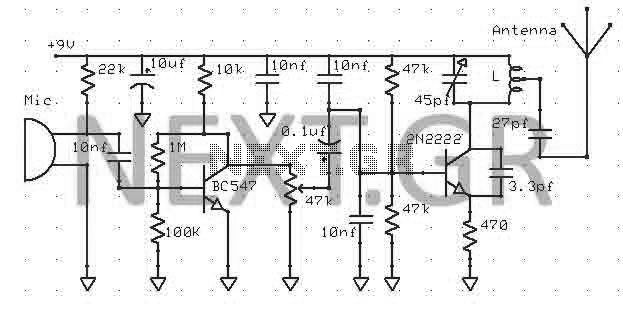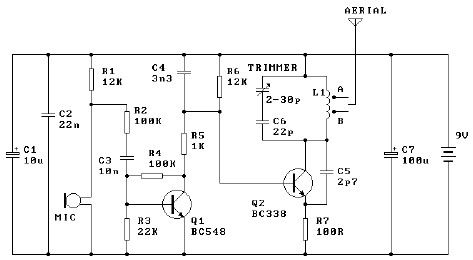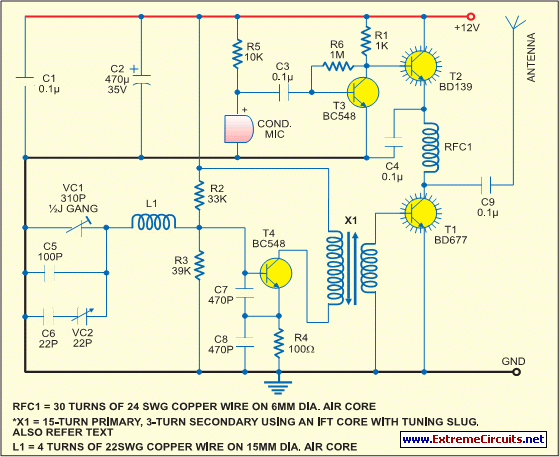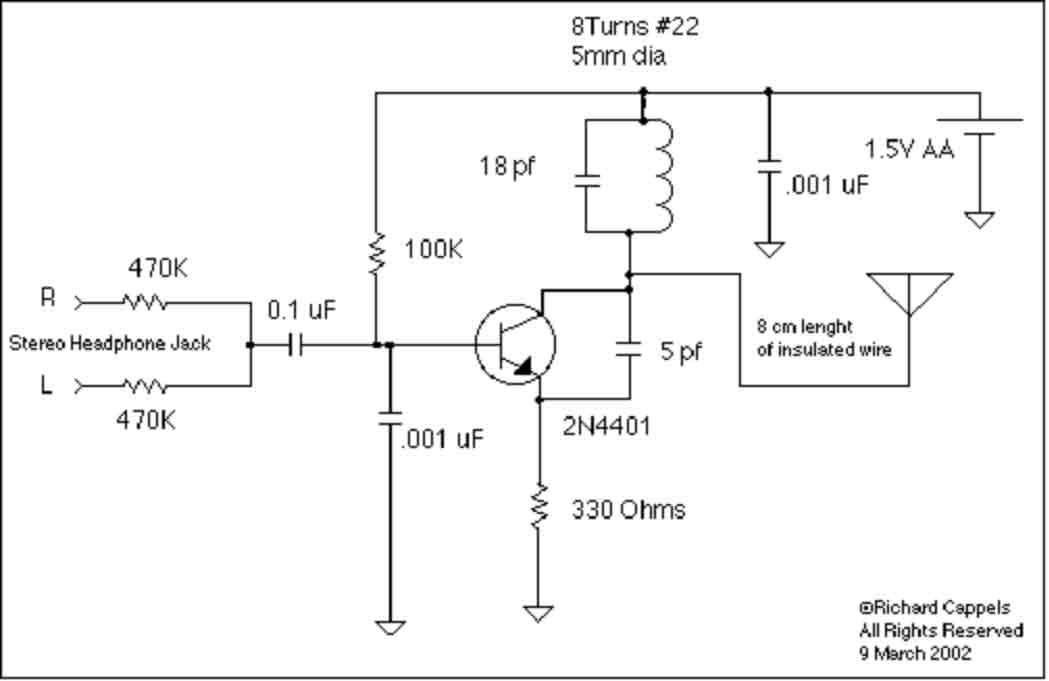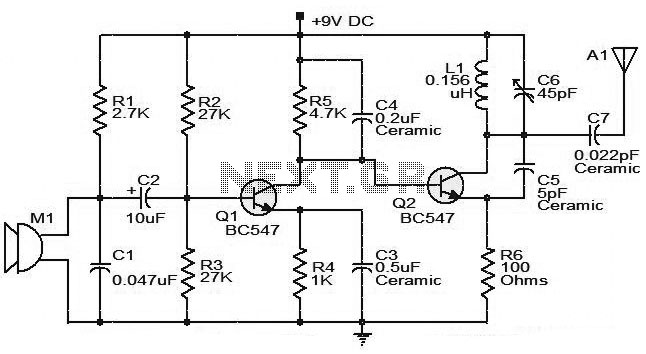
pyro rf transmitter 27mhz
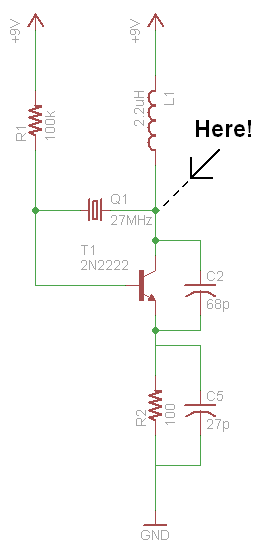
Instead of concentrating on the mathematical and theoretical aspects of this simple pyro RF transmitter, the focus will be on the components within each stage. The mathematics involved in understanding how and why this circuit operates is complex and cumbersome. Therefore, a more practical approach is taken to build the circuit and gain an intuitive understanding of its functionality. The schematic will be examined step by step to comprehend each part of the circuit, its purpose, and the appearance of signals at critical points. The analysis will be divided into three sections: first, the generation of the signals intended for transmission; second, the examination of these signals during the transmission process; and third, the measurement of the transmitter's power output. Initially, it is essential to generate the signals for transmission. Referring to the schematic, the section responsible for activating the crystal oscillator is observed. The circuit produces a sine wave at the desired frequency. Although the absence of filtering introduces various harmonic frequencies that slightly distort the results, the signal remains usable. The next signal to be generated is a lower frequency on/off digital signal, which is produced using a simple 555 timer in the configuration provided. The output is a clear square wave, as anticipated. Subsequently, the interaction between these two signals will be explored.
The pyro RF transmitter circuit comprises several key components that work in concert to generate and transmit signals effectively. The first stage involves the crystal oscillator, which is crucial for establishing a stable frequency output. The oscillator typically employs a quartz crystal that resonates at a precise frequency when an AC voltage is applied. This resonance produces a sine wave signal, which is essential for the RF transmission. Although harmonics are present due to the lack of filtering, they can often be tolerated in practical applications, provided that the fundamental frequency remains intact.
Next, the circuit incorporates a 555 timer configured in astable mode, generating a square wave signal at a lower frequency. This square wave serves as a digital on/off control signal that modulates the amplitude of the sine wave generated by the oscillator. The output of the 555 timer is characterized by sharp transitions between high and low states, making it suitable for digital applications where precise timing is critical.
The combination of the sine wave and the square wave occurs in the mixing stage of the circuit. This stage is designed to modulate the RF signal with the digital control signal, effectively encoding the information to be transmitted. The mixing process can be accomplished using a variety of methods, including analog multipliers or diode mixers, depending on the desired outcome and complexity of the circuit.
Finally, the power output stage of the transmitter amplifies the modulated signal to a suitable level for transmission. This stage may include RF amplifiers that boost the signal strength while maintaining the integrity of the modulation. Measurements taken at this stage provide insights into the efficiency and performance of the transmitter, including power output levels and signal quality.
In conclusion, the pyro RF transmitter circuit is a nuanced assembly of components that work together to generate, modulate, and transmit signals. Understanding the function of each component and the interactions between them is crucial for designing effective RF transmission systems.Instead of focusing on the mathematical and raw theoretical side of this simple pyro RF transmitter, we`ll be focusing on the elements in each of the stages. The math of how/why this circuit actually works is horridly ugly and way too complicated. so it`s funner (for me) to just build and get a `feeling` for what works and why and where and how. So let`s take some time to go through the schematic step by step to understand each part of the circuit, what it`s purpose is and what the signals look like at specific important points. We will go through 3 sections, first taking a look at how the signals we want to transmit are generated, then moving on to see how those signals look when we finally want to transmit them and then finally we`ll look at some measurements of the power output of the transmitter.
Before we can do anything for this transmitter, we need to generate the signals that we`ll be transmitting. So first, looking back at the schematic, here is the part of the circuit that gets the crystal oscillator going: Above you can see that the circuit outputs a sin-wave at the frequency we`re looking for.
Because there is no filtering many harmonic frequencies are present that skew our results slightly, but this signal will work. The next signal that we want to generate is the lower frequency on/off `digital` signal. We use a simple 555 timer to do that with the configuration seen below: The output is a solid square wave, just as we would expect to see.
Now, let`s see what happens when these two signals are mixed together! 🔗 External reference
The pyro RF transmitter circuit comprises several key components that work in concert to generate and transmit signals effectively. The first stage involves the crystal oscillator, which is crucial for establishing a stable frequency output. The oscillator typically employs a quartz crystal that resonates at a precise frequency when an AC voltage is applied. This resonance produces a sine wave signal, which is essential for the RF transmission. Although harmonics are present due to the lack of filtering, they can often be tolerated in practical applications, provided that the fundamental frequency remains intact.
Next, the circuit incorporates a 555 timer configured in astable mode, generating a square wave signal at a lower frequency. This square wave serves as a digital on/off control signal that modulates the amplitude of the sine wave generated by the oscillator. The output of the 555 timer is characterized by sharp transitions between high and low states, making it suitable for digital applications where precise timing is critical.
The combination of the sine wave and the square wave occurs in the mixing stage of the circuit. This stage is designed to modulate the RF signal with the digital control signal, effectively encoding the information to be transmitted. The mixing process can be accomplished using a variety of methods, including analog multipliers or diode mixers, depending on the desired outcome and complexity of the circuit.
Finally, the power output stage of the transmitter amplifies the modulated signal to a suitable level for transmission. This stage may include RF amplifiers that boost the signal strength while maintaining the integrity of the modulation. Measurements taken at this stage provide insights into the efficiency and performance of the transmitter, including power output levels and signal quality.
In conclusion, the pyro RF transmitter circuit is a nuanced assembly of components that work together to generate, modulate, and transmit signals. Understanding the function of each component and the interactions between them is crucial for designing effective RF transmission systems.Instead of focusing on the mathematical and raw theoretical side of this simple pyro RF transmitter, we`ll be focusing on the elements in each of the stages. The math of how/why this circuit actually works is horridly ugly and way too complicated. so it`s funner (for me) to just build and get a `feeling` for what works and why and where and how. So let`s take some time to go through the schematic step by step to understand each part of the circuit, what it`s purpose is and what the signals look like at specific important points. We will go through 3 sections, first taking a look at how the signals we want to transmit are generated, then moving on to see how those signals look when we finally want to transmit them and then finally we`ll look at some measurements of the power output of the transmitter.
Before we can do anything for this transmitter, we need to generate the signals that we`ll be transmitting. So first, looking back at the schematic, here is the part of the circuit that gets the crystal oscillator going: Above you can see that the circuit outputs a sin-wave at the frequency we`re looking for.
Because there is no filtering many harmonic frequencies are present that skew our results slightly, but this signal will work. The next signal that we want to generate is the lower frequency on/off `digital` signal. We use a simple 555 timer to do that with the configuration seen below: The output is a solid square wave, just as we would expect to see.
Now, let`s see what happens when these two signals are mixed together! 🔗 External reference
